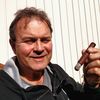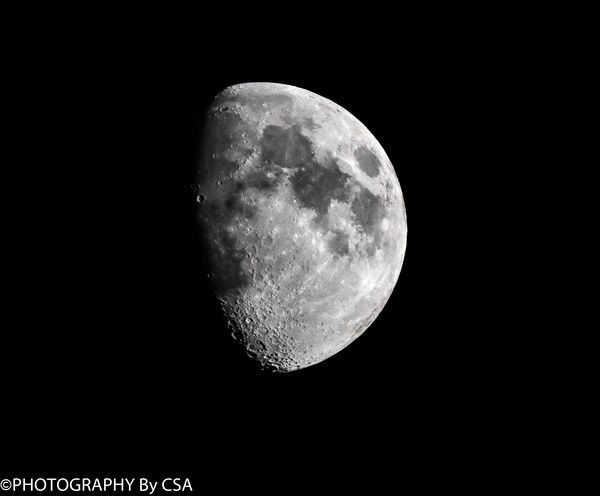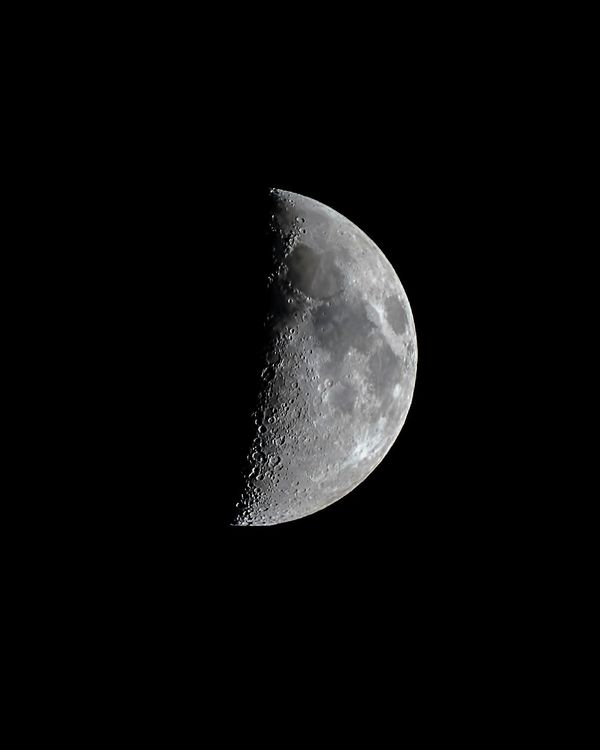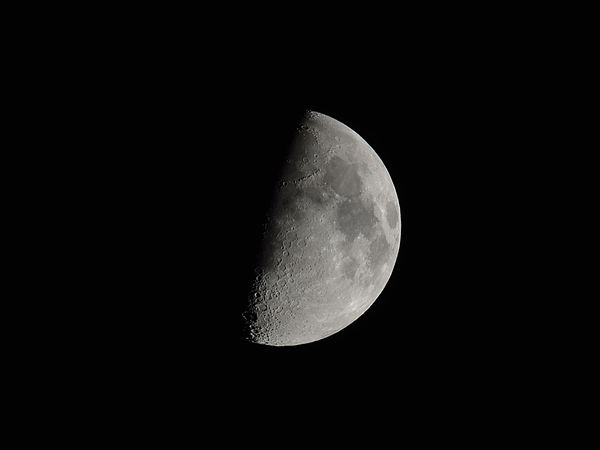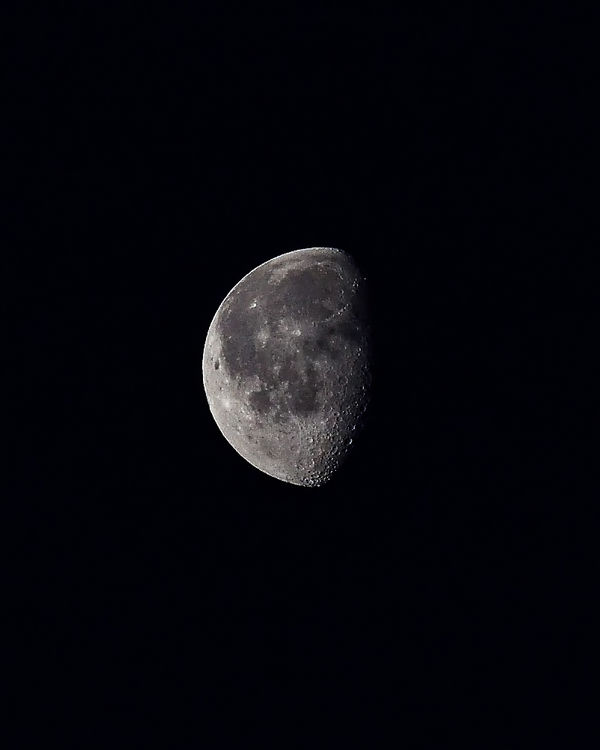full moon brightness
Aug 9, 2017 12:15:54 #
You need to be in manual mode and spot meter on the moon itself. Stop your exposure down to f/10 or f/11, set your shutter to anywhere between 1/200s to 1/320s and your ISO to between 100 and 200, lower is better if you can but then you'll need a higher shutter speed etc. Best results are with a long reach lens, anything above about 800 full frame equivalent. Cropped dslr sensors and the mirrorless sensors improve your reach. Currently I don't have a long enough reach lens for my Pentax K-3 but I have a bridge camera, the Canon SX50 HS which has a reach of about 1200mm (FF equiv). It has it's limitations but does a pretty good job. I can only stop it down to f/8 and have to adjust the other settings for a good exposure.
Just keep shooting and having fun!
John
Just keep shooting and having fun!
John
Aug 9, 2017 14:27:39 #
ORpilot wrote:
For those that are unfamiliar with the Canon SX 50, it is a bridge camera. The maximum optical zoom is the equivalent to 1200mm and the you have digital zoom beyond that. For the $$$$ it is tough to beat any long zoom bridge camera for those shots needing a long zoom. I could never affor to own, let alone rent a quality 1200mm+ plus lens for my DSLR. I am very happy with my SX50.
I intend to buy one. The price is lower now that the SX60 is out. I keep checking the pawn shops hoping I might luck up one. One thing I learned is never buy that type of camera without it having a viewfinder.Electronic or optical. With nothing but a back display they are useless in bright sunlight.
Aug 9, 2017 14:31:21 #
Johannes Mac wrote:
You need to be in manual mode and spot meter on th... (show quote)
You forgot one thing. Tripod! When taking that SX-50 out to max optical zoom you better use a tripod. Or have hands as steady as a statue. One thing I avoid is going into the digital zoom range. Too much loss of quality.
Aug 9, 2017 16:39:39 #
Also you cannot use digital zoom in anything but automatic mode. The SX50 HS is supposed to be better than the SX60 HS in terms of picture quality as well. At least that's according to the reviews I read. 

Aug 9, 2017 17:17:23 #
Johannes Mac wrote:
Also you cannot use digital zoom in anything but automatic mode. The SX50 HS is supposed to be better than the SX60 HS in terms of picture quality as well. At least that's according to the reviews I read. 

In other words "new and improved" is not the case. It happens all the time unfortunately. With anything from laundry detergent to candy bars. And don't forget the "New Coke". If it ain't broke don't fix it.


Aug 9, 2017 20:22:08 #
izzT5obi wrote:
Tried to get shot of full moon with t5, Av mode 18f, 200 iso, shade wb, gave me 30 sec exposure but the brightness just gave a glow and not the sharpness of the moon landscape, canon efs 50-250 lens, Tree on left side in foreground, shows underexposure in histogram,"blinky" on moon. tried various exp comp settings. moon had nice glow but would like to get rid of glow "blob" effect and get the sharpness instead. Thank you for helping this novice.
When I shoot pictures of the Moon, I set my ISO between 1600 and 3200. My Aperture to F8 or 9 (sweet spot) and sometimes higher, and my shutter to 2000/sec, 2500/sec or more.
The faster the shutter the less light enters the camera. I use a Nikon D7200 with a Sigma 150/600. This is the result. I wish you many good evenings of shooting this great heavenly body !
Aug 9, 2017 21:17:57 #
Catchnreel wrote:
When I shoot pictures of the Moon, I set my ISO between 1600 and 3200. My Aperture to F8 or 9 (sweet spot) and sometimes higher, and my shutter to 2000/sec, 2500/sec or more.
The faster the shutter the less light enters the camera. I use a Nikon D7200 with a Sigma 150/600. This is the result. I wish you many good evenings of shooting this great heavenly body !
The faster the shutter the less light enters the camera. I use a Nikon D7200 with a Sigma 150/600. This is the result. I wish you many good evenings of shooting this great heavenly body !
Well done.

Aug 9, 2017 21:42:10 #
Catchnreel wrote:
When I shoot pictures of the Moon, I set my ISO between 1600 and 3200. My Aperture to F8 or 9 (sweet spot) and sometimes higher, and my shutter to 2000/sec, 2500/sec or more.
The faster the shutter the less light enters the camera. I use a Nikon D7200 with a Sigma 150/600. This is the result. I wish you many good evenings of shooting this great heavenly body !
The faster the shutter the less light enters the camera. I use a Nikon D7200 with a Sigma 150/600. This is the result. I wish you many good evenings of shooting this great heavenly body !
Personally I would opp for a lower ISO. 100 or 200 with the camera on a sturdy tripod is fine. Since the moon is a direct reflection of the sun you can basically calculate ISO 100, 1/500, at f8. That's a good starting point. Atmospheric conditions may change that. Bracket 1/2 stops up -1 to +2. With digital shoot away and review the results and make any necessary changes. f8 is normally considered the sweet spot. You'll be focused at infinity so unless you include a foreground object DOF is not a problem.
Aug 9, 2017 21:45:12 #
Johannes Mac wrote:
You need to be in manual mode and spot meter on th... (show quote)
There is no one way to shoot anything.
The first image was at ISO100, 1/125s, f6.3, 400mm
The second at ISO400, 1/200s, f5.6, 420mm (300 w/TC)
The third at ISO 400, 1/2500s, f5.6, 180mm
Different times, conditions and cameras but all work to some degree.

Aug 9, 2017 21:53:59 #
joer wrote:
There is no one way to shoot anything.
The first image was at ISO100, 1/125s, f6.3, 400mm
The second at ISO400, 1/200s, f5.6, 420mm (300 w/TC)
The third at ISO 400, 1/2500s, f5.6, 180mm
Different times and conditions but all work to some degree.
The first image was at ISO100, 1/125s, f6.3, 400mm
The second at ISO400, 1/200s, f5.6, 420mm (300 w/TC)
The third at ISO 400, 1/2500s, f5.6, 180mm
Different times and conditions but all work to some degree.

Yep. Photography 101. Just study the basics. It ain't rocket science. Just learn the basics of ISO, shutter speed, and aperture and how they relate. Change one and something needs to change to get the same results. Sort of like Ohm's law in electronics. The relationship of voltage, current, and resistance.
Aug 10, 2017 00:15:37 #
larryepage
Loc: North Texas area
Remember that the intensity of sunlight on the moon is +/- 0.5 % of the same sunlight that strikes the earth at the equator at noon. Atmospheric effects end up being almost identical. So you can always start by following the "Sunny 16" rule...exposure of f/16 at a shutter speed equal to 1/ISO (or the equivalent). And the moon isn't really white. The image our eyes receive is "overexposed" because we see it on such a dark background. Our eyes do not have spot metering, and the high contrast fools our biological matrix metering system into using too wide a lens opening.
Aug 10, 2017 09:19:02 #
DavidPine
Loc: Fredericksburg, TX
Shoot from a tripod @ 250mm. ISO 100, Shutter Speed 1/200, Aperture f/11. The moon is very bright and the earth's rotation is very fast. You might even try a faster shutter speed like 1/250.
izzT5obi wrote:
Tried to get shot of full moon with t5, Av mode 18f, 200 iso, shade wb, gave me 30 sec exposure but the brightness just gave a glow and not the sharpness of the moon landscape, canon efs 50-250 lens, Tree on left side in foreground, shows underexposure in histogram,"blinky" on moon. tried various exp comp settings. moon had nice glow but would like to get rid of glow "blob" effect and get the sharpness instead. Thank you for helping this novice.
Aug 10, 2017 15:16:00 #
Aug 10, 2017 15:20:50 #
pounder35 wrote:
Personally I would opp for a lower ISO. 100 or 200... (show quote)
Thank you sir for the recommendation, I shall try a lower ISO to see the outcome, appreciate the thought !!
Also because I shoot so fast, my shooting is done handheld. Will try the tri-pod as well, usually only use them for time-lapse.
Aug 10, 2017 15:49:54 #
Catchnreel wrote:
Thank you sir for the recommendation, I shall try a lower ISO to see the outcome, appreciate the thought !!
Also because I shoot so fast, my shooting is done handheld. Will try the tri-pod as well, usually only use them for time-lapse.
Also because I shoot so fast, my shooting is done handheld. Will try the tri-pod as well, usually only use them for time-lapse.
Waiting on the totality will be easier with a tripod and the camera settings ready. Manual exposure control and lens (lenses) set to infinity. Then it's f8 and wait. That's kind of catchy.
 Good luck with your photos. I'm hoping for clear skies.
Good luck with your photos. I'm hoping for clear skies.
If you want to reply, then register here. Registration is free and your account is created instantly, so you can post right away.
